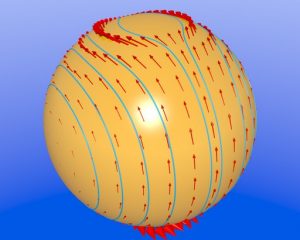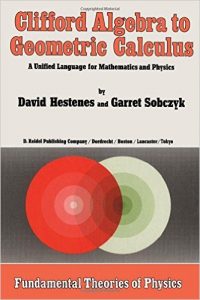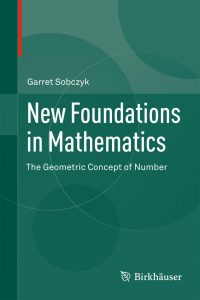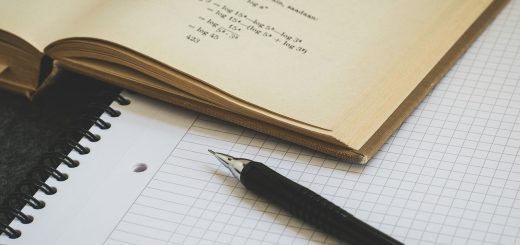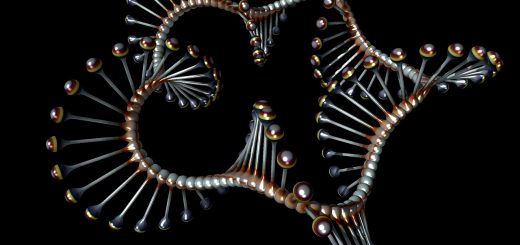Founders of Geometric Calculus
Foundations of modern Geometric Algebra and Geometric Calculus were laid down by Prof. David Hestenes and Dr. Garret Sobczyk 50 years ago. In this post, I interview Dr. Garret Sobczyk who tells us about his fascinating life journey with Prof. Hestenes. Their journey eventually inspired many researchers to follow their lead in learning, developing, and applying Geometric Algebra and Geometric Calculus to many fields of science.
The Fellowship of Founders
Thank you, Ahmad, for giving me the opportunity to share with you some of my early memories as a graduate student at Arizona State University (ASU) working in geometric algebra.
It was in 1965 when I had just completed my Master’s Degree in Mathematics and was looking for direction to continue my studies for a Ph.D. that I decided to explore possibilities in mathematical physics. Professor David Hestenes, a new professor at ASU, was offering a course in electrodynamics that caught my attention. On the first day of class, he began by introducing Geometric Algebra (GA) and the geometric product of vectors. I was amazed that I had never heard of the concept of a bivector as a directed area, or of the geometric product of vectors. It was over the course of that year that I decided that I wanted to dedicate my efforts for my Ph.D. into developing GA as a basic language in mathematics that I believed it to be then, and still do now a half a century later!
Indeed, I did not have an easy beginning. David, at first suggested topics in Kellogg’s Potential Theory and Harmonic Analysis or generalizing Elliptic Functions. All of these were very good topics which have been extensively developed by European groups such as the Delanghe-Sommen group in Belgium, and others, but I was unable to make any real progress in these areas. It was at this point, almost in desperation, that I started to look at very basic ideas in linear algebra and differential geometry. Surely, if GA was indeed a basic language (over the continual skepticism of my Father; then a Professor of Mathematics at Clemson University, with a Ph.D. from Princeton University when he was a 23 year old), GA should offer new insights in these basic fields. Even to this day, most mathematicians believe that trying to reformulate differential geometry in GA is only putting old wine in new bottles.
I undertook a serious study of linear and multilinear algebra out of books by Gel’fand, Shilov, and Greub, and basic differential geometry. I was also greatly influenced by books such as “Science Awakening” by van der Waerden, Tobias Dantzig’s book, “Number The Language of Science”, Wilder’s “Evolution of Mathematical Concepts”, and Michael Crowe’s “History of Vector Analysis”. I considered my first “breakthrough” in linear algebra to be when I discovered how to derive the Cayley-Hamilton theorem in GA by first looking at the simplest 2-dimensional case. I spent a great deal of time developing the notion of the vector and simplicial derivatives in GA as a basic tool in linear algebra. Almost all of my 1971 Ph.D. thesis consisted of a systematic development of the general simplicial derivative as a basic tool in linear algebra.
It was only toward the end of my thesis that I was able to start making progress in laying down the basic ideas of Riemannian Curvature in differential geometry, material which David and I developed further over a period of four years afterwards, and would later make up the heart of our book “Clifford Algebra to Geometric Calculus: A Unified Language for Mathematics and Physics”, which wasn’t published until a decade later in 1984.
Facing the Real World
After finishing my Ph.D. at ASU in 1971, I was unsuccessful in obtaining any academic position. The first academic job crunch was on and for every teaching position at a University or College there were hundreds of applicants, and Mathematics Departments to which I applied were suspicious of me working in an unknown area and with a young theoretical physicist as my thesis adviser. Fortunately, ASU kept me on for an additional year as a Visiting Assistant Professor, which gave us the chance to continue working closely together in developing GA. At first, we planned on publishing four papers, which later formed the basis of our book. The following year, I was still unsuccessful in obtaining any academic position.
At first, I visited a number of American University Mathematics Departments with well-known people in differential geometry, but none were interested in GA or in my work. I also realized that my basic knowledge of differential geometry was insufficient to convince anyone of any need to reformulate it in a new language. In 1973, I visited European Universities in different countries and was invited to give a number of talks about GA, but it was only in Poland that I was offered a Research Fellowship with the Polish Academy of Sciences, which allowed me to continue to develop basic tools in GA that eventually went into our book CA to GC in 1984. I returned to Poland in 1976 with a Postdoctoral Research Grant from Stoney Brook University in NY, allowing me to continue my work with new colleagues at the Institute of Theoretical Physics in Wroclaw until 1980.
I enjoyed two academic appointments as an Assistant and Associate professor of Mathematics at Spring Hill College, Mobile, Ala., and at Lander College, Greenwood, SC in the 1980’s, and began developing material to teach undergraduate students GA and calculus. Finally, in 1984, our book CA to GC was published, which provided a needed boost to my career, but even to this day, the book has been largely ignored by the majority of the Mathematics Community.
It was difficult to teach GA and GC to students at this level because it usually takes a full year to get students comfortable with GA, and an undergraduate student is expected to master many other subjects as well. As my Finnish friend and colleague, the late Professor Pertti Lounesto remarked, about the best you can do is “smuggled it in” under the guise of closely related material, such as vector analysis and differential forms.
Fortunately, during the 1990’s and into the new century, Professor Hestenes was successful at drawing considerable new interest to the area among computer scientists and engineers, by utilizing GA in an innovative way to lay down the foundations of projective and conformal geometries.
In 1990 I accepted a very promising offer by Professor Jaime Keller of the Universidad Nacional Autonoma de Mexico to work with him as Assistant Editor of the new International Journal that he was creating, “Advances in Applied Clifford Algebras”, with the hope of both consolidating this growing field of research, and promoting wider international recognition. It was an exciting two years of growth, and of discovering the exotic culture of modern Mexico, alongside the ancient Mayan civilization that may well have been among the earliest to invent the concept of the number zero, and a base 20 type number system.
At the Universidad de Las Americas – Puebla, over the years 1993 – present, I continued to develop material for teaching GA at the undergraduate level, with an emphasis on basic linear algebra and elementary differential geometry, leading to the publication of my book, “New Foundations in Mathematics: The Geometric Concept of Number”, Birkhauser-Springer 2013. In this book, I emphasize the development of linear algebra and basic ideas of differential geometry in terms of GA, including the basic concept of the spectral basis. The idea of a spectral basis is what really connects the ideas of a geometric algebra to the traditional approaches to linear algebra and ubiquitous matrices. When GA is properly understood as providing a geometric basis for matrices, the well-established consistency of matrix algebra, in turn, proves the mathematical soundness of GA, without the need to go into more complicated arguments involving tensor analysis and the higher level abstract concepts of advanced mathematics. Also, in the book, I lay down preliminary material on application of the idea of a spectral basis in basic ideas in numerical analysis, such as Hermite interpolation and rational approximation.
Present and Future
Clifford analysis, as developed by various groups, both in the United States and Europe enjoys recognition as a respectable area of research in advanced mathematics. In addition to the work of Professor Hestenes, Professor Baylis in Canada, other researchers in Mexico, China and around the World, geometric algebra has enjoyed increasing success among theoretical physicists in relativity and quantum mechanics. Clifford algebra is also used by some of the top theoretical physicists at prestigious universities in string theory and its generalizations. As you know, it has also attracted significant and growing attention in the computer science and engineering communities.
Each Clifford geometric algebra provides a general vector analysis for a geometry of a higher dimensional vector space. Probably the simplest way to introduce them to the widest possible audience is to directly relate them to the most familiar mathematical object that fully captures their essence. By a geometric matrix algebra I mean a real or complex matrix algebra of order 2^n x 2^n. The simplest case, when n=1, is for 2×2 real or complex matrices. The next case, when n=2, is for 4×4 real and complex matrices. Once the reader understands these two important special cases, which cover the important geometric algebras of 3 dimensional Euclidean space and the 4 dimensional Dirac algebra of spacetime, referred to by Hestenes as spacetime algebra, all other geometric algebras can be constructed by taking Kronecker products of successive copies of the 2×2 real and complex geometric matrices. This approach to geometric algebra is systematically explored in my new book, “Matrix Gateway to Geometric Algebra, Spacetime and Spinors”, available online here. A short 2 page introduction to geometric matrices, of orders 2×2 and 4×4, is provided in the Appendix of my article, “Notes on Plucker’s relations in geometric algebra”, to appear in Advances in Mathematics 363, 106959, March 2020. Elsevier has kindly provided a temporary free access link to this article, which can be found at this link.
I have no easy answer to this question. One of the main obstacles to teaching GA is the lack of powerful computer software to aid and check abstract hand calculations, although many new software products are becoming available. Two software packages that I have found to be useful in my teaching and research is the original stand-alone early numerical software package “CLICAL” by Lounesto, and the Mexican developed Mathematica Package [cliffordt.nb] 2007, by G. Aragon-Camarasa, J.L. Aragon, and M.A. Rodriguez. There are quite are a number of recent attempts to introduce GA at the undergraduate level that I am aware of. However, GA is still hardly recognized at all at the undergraduate level, as I firmly believe that it should be. I believe that it is the natural completion of the concept of number to include the concept of direction, and it should be taught that way down into the high school level. It is in this area that I have concentrated my own efforts. There is much left to be done to correctly lay down the foundations, even at a fundamental level, in order to facilitate progress at progressively more advanced levels in mathematics, physics, computer science, and engineering, including diverse areas such as quantum computing, robotics, the structure Lie groups and Lie Algebras, and artificial intelligence. The future lies in the hands of the younger generations.




